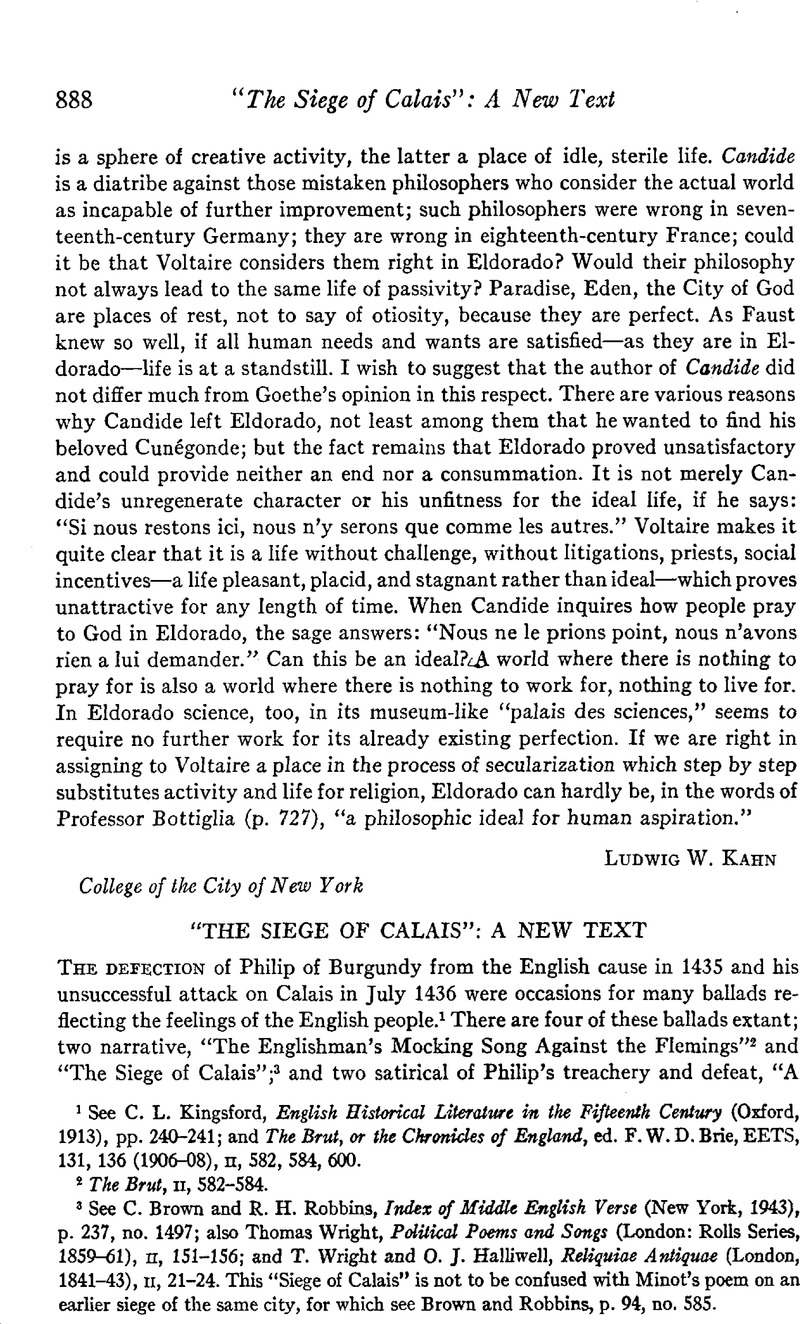No CrossRef data available.
Article contents
“The Siege of Calais”: A New Text
Published online by Cambridge University Press: 02 December 2020
Abstract

- Type
- Notes, Documents, and Critical Comment
- Information
- Copyright
- Copyright © Modern Language Association of America, 1952
References
1 See C. L. Kingsford, English Historical Literature in the Fifteenth Century (Oxford, 1913), pp. 240-241; and The Brut, or the Chronicles of England, ed. F. W. D. Brie, EETS, 131, 136 (1906-08), ii, 582, 584, 600.
2 The Brut, ii, 582-584.
3 See C. Brown and R. H. Robbins, Index of Middle English Verse (New York, 1943), p. 237, no. 1497; also Thomas Wright, Political Poems and Songs (London: Rolls Series, 1859-61), ii, 151-156; and T. Wright and O. J. Halliwell, Reliquiae Antiquae (London, 1841-43), ii, 21-24. This “Siege of Calais” is not to be confused with Minot's poem on an earlier siege of the same city, for which see Brown and Robbins, p. 94, no. 585.
4 Wright, Political Poems, ii, 148-149.
5 The Brut, ii, 600-601. Dr. H. N. MacCracken claims Lydgate authorship for this. See Minor Poems of Lydgate, EETSES, 70 (1911), p. xvii; and Anglia, xxxiii (1910), 283-286.
6 English Coll. MS. 1306 consists of 159 unnumbered folios, of paper. Dated as 1436-56 (according to the watermarks), the volume contains also Lydgate's Life of Our Lady; his Dance of Machabre; Benedict Burgh's Parvus Cato and Cato Major; The Master of Game, a prose treatise on hunting by Edward, Second Duke of York; and ten minor poems, mostly Lydgate's. Professor George Parks (Queens Coll.) and Dr. MacCracken (Vassar) told me about the new MS., for which information I am grateful. My article giving a full account of the Rome MS. and a description of its contents has been accepted for publication by the MLQ.
7 English Coll. MS. 1306 contains also a new and complete 112-line text of “A Song Made of the Duke of Burgundy.” This text supersedes the incomplete 43-line copy printed by Wright from Sloane MS. 252, f. 169a. Dr. H. N. MacCracken and the present writer will include this new text in a critical study of Lydgate's poetry now in preparation.
8 For the most complete account of the Siege of Calais and the identification of those persons mentioned in the poem, see The Brut, ii, 572-584. The Siege is also described at length in An English Chronicle, 1377-1461, ed. J. S. Davies, Camden Ser., 1st Ser. (1856), p. 55; in the Latin Brut (see Kingsford, pp. 321-322); in the Waltham Annals, 1422-1447 (see Kingsford, p. 352); and in the Recueil des Chroniques d'Engleterre, 1431-1447, J. Waurin (London: Rolls Ser., 1884), pp. 157-199. Lydgate refers to the attack in “The Debate of the Horse, Goose, and Sheep,” 11. 412-420 (see MacCracken, Minor Poems, p. 556).
9 The flowery style of these opening lines, reminiscent of Chaucer, is in the poetic tradition of the century.
10 The line implies that Philip's army numbered more than 150,000 men.
11 “pavis”—large convex shield covering the whole body, said to have been developed in Pavia.
12 “Ribawdes”—irregular troops or retainers.
13 “Cressettes”—vessels of iron, holding pitched rope, oil, wood or coal, to be burned for light. The Latin Brut mentions “in cressetibus ardentibus in nocte vii M.” See Kingsford, p. 321 n.
14 “Maire”—The Brut names Robert Clidrowe as “pe Meyre.”
15 “skry”—crying out, clamor, shouting; see OED, s.v. “Scry,” sb.1, 1. The word has a later meaning of attack, or reconnoitre (OED, s.v. “Scry,” sb.1, 2), but since the battle does not begin until l. 97, I think the poet is referring to the clamor and outcries of the attacking forces under Philip.
16 The legend that St. Barbara's father was struck by lightning when he himself assisted in her martyrdom, caused her to be regarded as the patron saint in time of thunder storms and fire, and by analogy, as the protector of artillery-men.
17 See The Brut, ii, 578: ... “the Duyke lay not pere but ii days, but pat he remeved from thens ... to pe Est ende of pe toun, and pere he pichet his tentes; for he wold ly no lenger att pe west ende of pe toun, for cause a gune shotte thrugh his tent”
18 The identity of this “Irissh man” is a mystery. However, his presence and exploits are an interesting feature of the account.
19 See The Brut, ii, 583, “Song on Siege of Calais”:
Remembres eke on Goby, the watir-bailiffes dog,
How he scarmysshed with you twyes vpon the day,
And among you, on pe sandes, made many a fray.
20 This defeat caused the Flemish to remember this day as “Bad Thursday.”
21 The plain of Saint-Pierre was a mile or so from Calais.
22 This attempt by Philip to block the harbor of Calais against any rescuing English fleet is described at length in The Brut, ii, 579.
23 Wright's edition of MS. Cotton Galba E. ix. adds:
Lytelle wote the fool,
Who my&czy;th ches,
What harm yt wer
God Caleys to lese. Amen.
These four lines are paraphrased in The Libelle of Englyshe Polycye, ll. 826-827:
For lytelle wenythe the fole, who so myght chese,
What harme it were gode Caleise for to lese.
See G. Warner, ed. (Oxford, 1926), p. 42.


